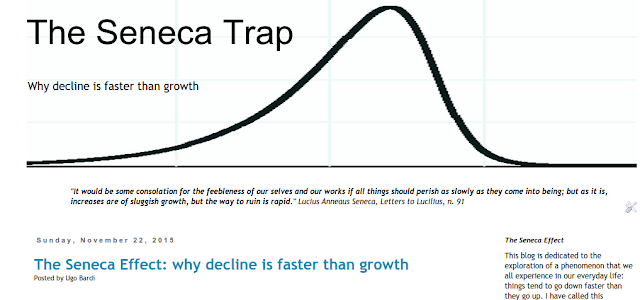A new blog dedicated to the Seneca Effect
The idea of collapse is bad enough for most people when it deals with the running out of mineral resources along the symmetrical “bell shaped” Hubbert curve. But there is an extra dimension to collapse: it is the “Seneca Effect” (or “Seneca Trap”, or also “Seneca Cliff”) that notes how, most often, when things start going bad, they go bad fast – even very fast.
So, a few years ago I started mulling over this idea, also as the result of a question that Dmitry Orlov had posed to me. I also remembered something that the ancient Roman Philosopher Seneca had written and that a friend of mine (Luca Mercalli) had pointed out to me. The result was the “Seneca Collapse model,” one of a series that I call “mind sized” simple models.
The basic idea of the Seneca Model, as I implemented it, is that a complex system, such as a whole civilization, does not collapse just because it runs out of resources, but also because of side effects related to the consumption of these resources, effects that we would call today “pollution”. Trapped in between depletion and pollution, the system collapses even faster. This is why I call the effect also the “Seneca Trap”.
After I had developed that first model, I discovered that the phenomenon may be more complex and that there are many real-world systems that can be considered as affected by the Seneca Trap. It can be applied, in particular, to fisheries. On the whole, it is a fascinating subject that I am still exploring.
…click on the above link to read the rest of the article…
